What is the Symbolism and Meaning Behind Celtic Knots?

Celtic knots - we see them everywhere, as decorations on jewelry, borders on rugs or picture frames, and in knitted clothing and scarves, but have you ever wondered about the meanings behind these intriguing designs?
Join me on a little exploration through the fascinating world of Celtic symbols.
Celtic knots and their meanings
With no beginning and no end, Celtic knots are known as symbols of eternity or infinity. They are often given as gifts between lovers, friends or family as a symbol of everlasting love, friendship or loyalty.
Celtic knots are ancient symbols and knot designs have been found in artwork as early as the 3rd century AD and can be seen on Roman floor mosaics.
Many iconic examples of Celtic knots can be found in the famous Book of Kells. These interlaced designs reflected Celtic beliefs in continuity and the interconnectedness of life.
Celtic trinity knot, or triquetra, meaning
The Celtic trinity knot, also known as a triquetra, is a three-pointed knot. The Celts felt that everything important in the world came in threes.
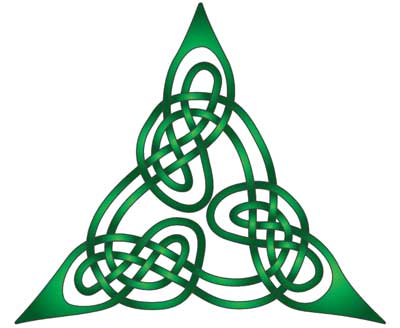
The number three had a deeply spiritual meaning and was found in many aspects of their culture. Here are just a few of those meanings:
- the three stages of life - youth, adulthood, old age
- the three elements - air, fire, water
- the three domains - earth, sea, sky
- past-present-future
- life-death-rebirth
In Celtic stories, questions were often asked 3 times. Laws, maxims, knowledge and poetry were always arranged in triads. The number three was always associated with luck, importance and magic.
The triquetra and similar Celtic knots also had great significance for Christians and could be found in Christian artwork throughout Britain and Ireland.
The Christian meaning of the triquetra is usually related to the holy trinity of the Father, Son & Holy Spirit. It also resembles three interlocking fish; the fish is an ancient Christian symbol that predates the crucifix by hundreds of years.
The number three is also significant for Christians because Jesus was resurrected in three days and the Devil made three unsuccessful attempts to tempt Christ in the desert.
When accompanied by a circle, the triquetra represents eternity or the unity of the three elements represented in the knot.
As a modern-day symbol, it can represent the three promises of a relationship - to love, honor and protect the person who wears it.
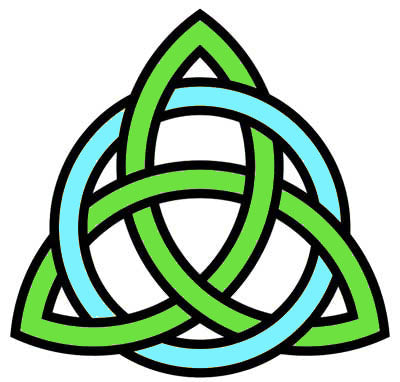
It is also considered to be a protective symbol, as the interwoven lines are thought to "confuse" negative energies.
Other modern-day uses include decorations in everything from jewelry and home decor to clothing and tattoos. In the hit TV show "Charmed", it represents the power of three.
Celtic spiral knot or triskelion meaning
The triskele or triskelion is an ancient symbol dating back to the Stone Age. The oldest surviving triskele is in Malta and is estimated to be 6500 years old.
The best known triskele is in a burial mound in Newgrange, Ireland, and is part of an astronomical calendar carved into rock. It dates back to 3200 BC.
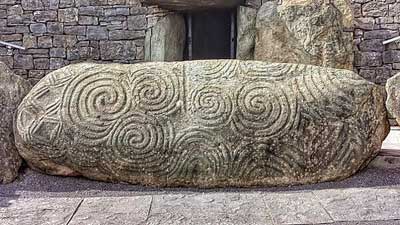
The Newgrange monument was designed to remain dark until the winter solstice, when it filled with light, illuminating the triple spiral designs on the walls.
Made of three spiral arms, the triskele seems to suggest a state of perpetual motion, as if its arms are moving outwards from the center.
As a symbol, it is thought to represent motion, progress, cycles and advancement and suggests that we should always be trying to grow, develop and become better in every way.
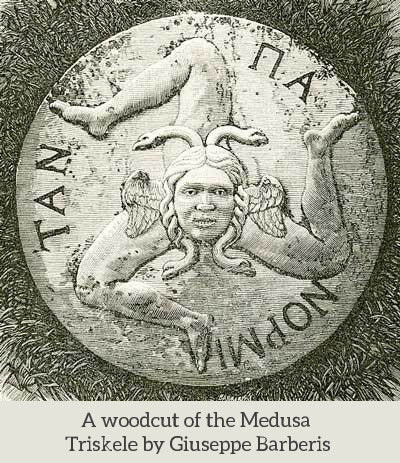
Like the trinity knot, it also represents the importance of things that come in threes. In addition to the meanings of the number three noted above, here are a few more:
- spirit-mind-body
- mother-father-child
- past-present-future
- creation-preservation-destruction
- the three Celtic worlds - spiritual, present, celestial
For Neopagans and Wiccans, the triskele also represents the Triple Goddess of the Mother, Maiden and Crone and the Rule of Threes, which is the idea that your deeds will visit you three-fold.
One interesting deviation from the original form of the triskele comes from the island of Sicily. The Gorgon, Medusa, was seen as the protector of the island. Her head is at the center, with three legs spinning around it to form the shape of the triskele.
Celtic Love Knot
Celtic love knots come in various shapes like ovals, circles or squares, bu their one defining feature is that they are made of two separate strands that are intertwined and inseparable from each other.
The two strands represent the union of two souls to be forever in love or forever in friendship.
Celtic Sailor's Knot
The Celtic Sailor's Knot is a simple, but elegant design made from the intertwining of two ropes (#3 in the diagram).
Dating back to ancient times when Celtic sailors left for long months at sea, these knots were woven to give to their loved ones when they returned.
It was a way for sailors to remember loved ones and also for the loved ones to remember the sailor when he was away.
Although the sailor's knot is simple to tie, it creates one of the strongest knots, symbolizing a bond that grows stronger under pressure and with the passage of time.
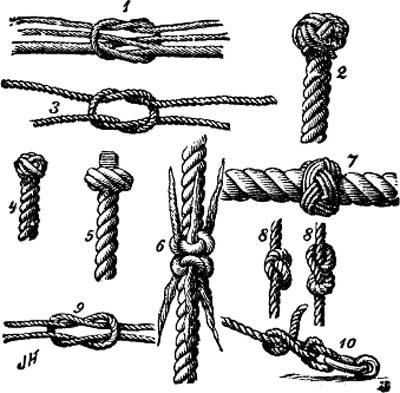
They have come to represent eternal friendship, harmony, affection and love, but are also believed to bring good fortune to the wearer and to keep them safe at sea.
One other interesting tidbit is that it was also used to wipe sweat from one's brow during hard physical labor, such as cleaning the deck or loading cargo.
Using the knot, even for something usually considered unclean, like wiping away sweat, somehow seems to make the knot more special to receive. This is especially true if it is given to a lover, since there may be some scent of the sailor left behind on the knot.
Celtic Dara Knot
The word "dara" can be traced back to the Irish word "doire" which means oak tree. The knot is a representation of an oak tree's root system.
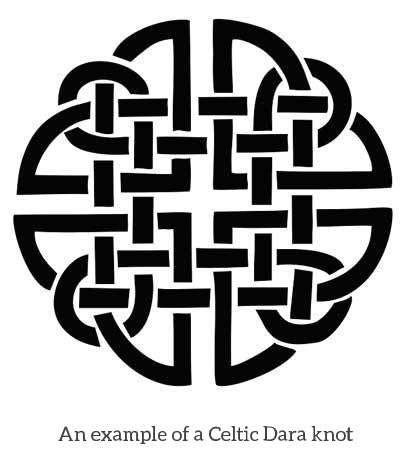
Trees were sacred to the Celts and especially the Druids. Known as the king of the forest, the oak tree was especially revered for its strength and longevity. It is said that the mighty oak is the tree most prone to lightning strikes and even when struck, it will continue to thrive.
Oak trees were a symbol of power, strength, wisdom and endurance. Because of this, the oak tree's roots, and thus the Dara knot, are a symbol of our own inner strength and wisdom.
Shield Knot
The Shield knot is similar to the Dara knot in that it always has four "leaves", but its design is usually simpler and starker. It often is in the shape of a circle, with its pathway weaving through the center to create a square shape.
The Shield knot is known as a symbol of protection and was placed near sick people to ward off evil spirits. It usually was drawn with thick strands, tightly-intertwined to represent and impenetrable, unbreakable barrier.
Quaternary Knots
Quaternary knots are any Celtic knots made of four leaves or elements and are symbols of things that come in fours. Here are just a few:
- the four directions
- the four seasons
- the four elements of earth, fire, water and air
- the four Celtic festivals of Samhain, Beltane, Imbolc and Lughnasadh
- the four great treasures of Tuatha de Danaan, the group who reclaimed Ireland from the Fomorians. The four treasures were magical talismans the men carried as defense and for attack - a spear, a stone, a sword and a cauldron.
- the emblem of Brigid, the Queen of Four Fires, who possessed the four wisdoms of hand, hearth, head and heart.
More Celtic Symbols
 Celtic Cross
Celtic Cross
The meaning behind the Celtic cross is debatable and shrouded in mystery, but these well-known symbols are prevalent in Irish culture and can be seen on any roadtrip through the Irish countryside.
Early crosses were about 8 feet high and later crosses were much taller, with the very tallest being an impressive 23 feet high. The Celtic "high" crosses with arms that do not extend outside the ring, were made between the 8th and 12th centuries.
Celtic crosses have their roots in ancient pagan beliefs. It is thought that the circle might have been a sun symbol or possibly a halo. It has also been suggested that the basic shape of the cross resembles trees, where were considered sacred.
Some sources say that the cross was introduced by St. Patrick. Legend says that St. Patrick combined the cross of Christianity with the pagan sun while trying to convert the heathen Irish.
Placing the cross on top of the circle symbolized Christ's supremacy over the pagan sun.
Other sources say that the cross originally had four even arms within the circle and was believed to be a sun symbol. St. Patrick then took this cross and extended one of its arms to make it look more like the Christian cross.
Claddagh Rings
Claddagh rings date back to 17th century Ireland and come from the Galway fishing village of Claddagh. They are sometimes used as friendship rings, but more commonly as engagement and wedding rings.
Claddagh rings are related to a group of European finger rings called "fede rings". The word "fede" comes from the Italian phrase "mani in fede", meaning "hands [joined] in faith" or "hands [joined] in loyalty".
It is said that the hands in the design represent friendship, the heart is for love, and the crown is for loyalty.
The rings also have a long tradition of being handed down as family heirlooms, usually from the mother to eldest daughter or from the grandmother to granddaughter.
During the Irish Potato Famine of 1845-1849, a million people died from disease or starvation and another million people fled the country.
 Claddagh rings were one of the few valuable possessions they kept with them on the journey. Sometimes, it was the family's only savings and became the daughter's inheritance.
Claddagh rings were one of the few valuable possessions they kept with them on the journey. Sometimes, it was the family's only savings and became the daughter's inheritance.
One famous legend tells about a sailor named Richard Joyce who came from the fishing village of Claddagh. It is said that he and his entire crew were captured by pirates and sold as slaves in Algeria.
Richard was purchased by a goldsmith who taught him his craft. He was kept for 14 years and after his release, he returned to Galway to find his true love, who was waiting for him.
Using specks of gold he had collected from the goldsmith's shop each day, he fashioned these into a ring for his sweetheart and went on to make many more rings. His initials can be found on one of the earliest Claddagh rings.
Did you know the Claddagh ring has special meanings depending on how its worn?
- When worn on the right hand, with the point of the heart towards the fingers, it means you are single and looking for love.
- When worn on the right hand, with the point towards your wrist, it means you are in a relationship.
- When worn on the left hand with the point of the heart towards the fingers, it means you are engaged.
- When worn on the left hand, with the point towards the wrist, it means you are married.
A nice motto that elegantly sums up the meaning of the Claddagh in just a few words is "let love and friendship reign".
The Claddagh also has meanings for Christians in that it represents the Holy Trinity, where the left hand symbolizes Jesus, the right hand is the Holy Ghost and the crown is for God.
St. Brigid's Cross
St. Brigid's Cross is a distinctive cross with a square at its center from which four arms radiate outwards. It is usually made of rushes, but sometimes straw is used as well.
The cross is thought to keep evil, fire and hunger away from the home where it is displayed.
St. Brigid, a patron saint of Ireland, is known as the founder of the first Irish monastery in County Kildare.
Legend says that when she was looking for a place to build her community, she asked the King of Leinster for a piece of land that she thought would be perfect for the convent - it was next to a forest where people could collect firewood and berries and there was a lake nearby to provide water.
When the king laughed at her proposale and refused to give her any land, she prayed to God to soften his heart. She then approached the king again and asked if he would be willing to give her only as much land as her cloak would cover.
The king, thinking she was joking, agreed to the ridiculous request.
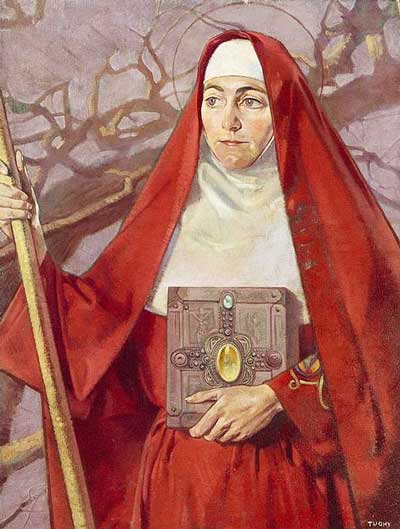 Instead of laying her cloak on the ground, Brigid gave it to her four sisters. With each one holding a corner of the cloak, they began to run in the four directions. The cloak grew and grew, soon covering many acres of land.
Instead of laying her cloak on the ground, Brigid gave it to her four sisters. With each one holding a corner of the cloak, they began to run in the four directions. The cloak grew and grew, soon covering many acres of land.
The king, fearing that her cloak would soon cover all his land, begged her to call back her sisters and he would give her a decent plot of land.
Brigid agreed, and soon afterward, the king converted to Christianity and began to help the poor and aided in the building of the convent.
The convent was known for making jam from the local blueberries which was sought all over Ireland. A new tradition is to eat jam on February 1st to honor this miracle.
The story of the creation of Brigid's cross begins with her being called upon to console a dying pagan chieftain. The man was restless and delirious. As she prayed by his bedside, she picked up some rushes from the floor and began weaving them into a cross.
After some time, the sick man became curious and asked what she was doing. As she began to explain the meaning of the cross, the man gradually calmed down. Inspired by the story, he asked to be converted to Christianity and was baptized before his death.
Ogham
Ogham was the first form of writing in Ireland and was used to record the earliest Irish texts dating from the 3rd to 6th century CE.
The Ogham alphabet is shrouded in mystery, but it is known that the names of many letters can be traced back to the names of individual sacred trees.
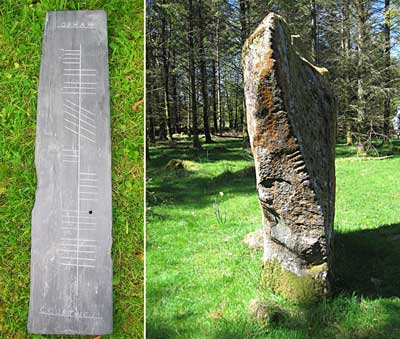
Ogham is made of groups of vertical lines, either slanted or flat, arranged along a vertical root and is read from bottom to top.
About 400 surviving examples of Ogham can still be found in Ireland and Western Wales. Written on standing stones and wood carvings, most inscriptions are of personal names.
Ogham was used for monuments and other practical purposes, such as keeping records and lists, but it also had magical purposes and is used for modern-day divination.
Shamrocks
The shamrock has long been associated with Irish culture and has been a symbol of Ireland since the 18th century.
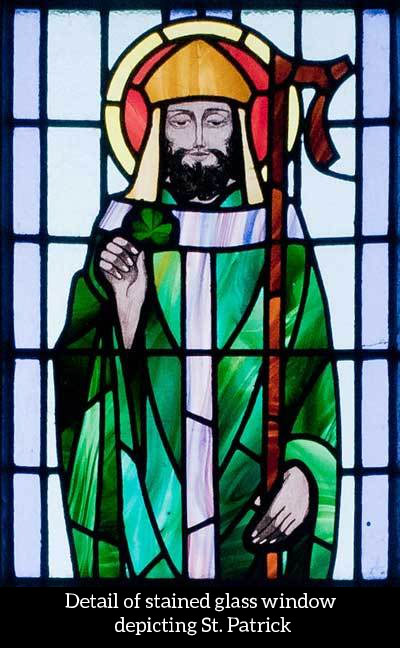
Because the shamrock has 3 leaves and because the number 3 had great significance to the Celtic people, it is thought that St. Patrick used the shamrock to turn the Celtic pagans towards Christianity.
One of the first links of the shamrock to St. Patrick is its appearance on St. Patrick's coppers or Halpennies in 1675. These appear to show St. Patrick preaching to a crowd while holding a shamrock.
There are also pictures of St. Patrick driving the snakes out of Ireland with a cross in one hand and a sprig of shamrocks in the other.
Today, shamrocks are used in St. Patrick's Day parades and celebrations worldwide.
Cernunnos
Known as the "Horned God of the Animals", Cernunnos is the protector of the forest and of all trees, plants and animals.
He is often shown with wild, shaggy hair and wearing the antlers of a stag. He holds a torc in one hand and a snake or large worm in the other, sitting cross-legged amongst the animals in a forest.
Cernunnos is known to be a fierce warrior who fights his enemies with the plants, roots and trees which he controls. However, he also has a gentle side and plays music when one of his enemies dies by his hands.
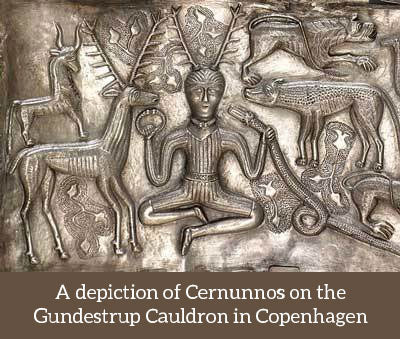
the Green Man
The Green Man is an ancient symbol with images that date long before the Christian religion, even before the days of the Roman empire.
He is usually a middle-aged or older man, whose face is surrounded with leaves, vines and flowers. Sometimes this vegetation sprouts from his mouth or sometimes his face is made entirely of leaves, seeming as if he is born from the natural world.
He is believed to be a symbol of growth and rebirth, the blossoming of spring and the cycles of the seasons.
But, just as spring leads to summer and then to winter, he is also a symbol of death and of endings. There are many images of the Green Man found on graves, but now, his face is an empty skull, yet still blooms with flowers and leaves.
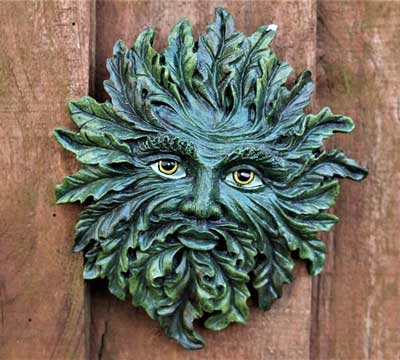
Today, modern pagans see the Green Man as a symbol of seasonal renewal and ecological awareness. In Wicca, he is one of the representations of the Horned God.
Celtic Symbols in Nature
Trees
Trees were sacred to the Celts and were thought to have links to the upper and lower worlds.
With their roots deep in the earth and their trunks growing high into the sky, it has been thought that the Celts believed the very top branches of trees swept against the edge of heaven.
The Celts, and especially the Druids, had a special reverence for oak trees. In fact, the word "Druid" comes from the Celtic word for "oak".
Depictions of sacred trees can be found on coins and altars, often accompanied by images of deities.
Water
Because of its cleansing and life-giving properties, water was seen as a symbol of purification, both of body and mind. The Celts believed that water, fresh and pure from a spring, had the power to cure disease.
They also felt that it was sacred because it had a cyclical nature and seemed to have a link to the upper and lower worlds.
When it fell from the sky as rain, they felt it was a gift from the sky god. This rain was then absorbed by the earth, later to reappear in springs.
Fire
The Celts had a sacred fire festival called Beltane, a name which is thought to have come from a Celtic-Gaelic word meaning "bright/sacred fire".
It was held to mark the blossoming of spring and was meant to celebrate the fertility of the land.
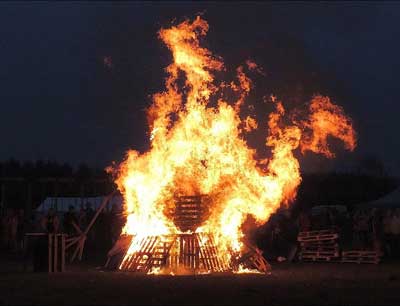
During the festival, all the fires in the community would be put out. A new fire would be lit, either by the head of the village or a spiritual leader.
From this new fire, one or two bonfires would be lit and all the animals of the community would walk around or between the fires.
This was thought to protect them in the coming year and increase their number of offspring. Finally, all members of the village would take pieces of the sacred fire back to their homes and relight their own hearths to bring them good fortune for the year.
Keeping the hearth fire alive was of great importance and it was only allowed to die once a year - on the eve of the Beltane festival.
If the fire died at any other time, it had to be "borrowed" from a neighbor and no one wanted to do that because it was believed that this gave the borrower power over the cattle and wealth of the lender.
Snakes
Celtic snakes can be found in Irish art, crafts and books and can have various meanings depending on the Celtic tribe.
Most commonly, they are seen as a symbol of rebirth because they have the ability to shed their skin, leaving behind an old version of themselves and starting over again, fresh and new.
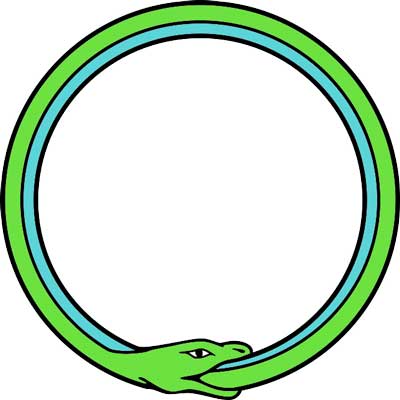
When the snake is seen in a coiled position, with its tail in its mouth, it is a symbol of infinity or the circle of life.
They are also known as a symbol of fertility because of their ability to produce many offspring.
Noteworthy Pieces of Irish Jewelry
Celtic Torc
The torc, also known as a torq or torque, was a large, rigid metal neck ring with an opening at one end. It was the most prestigious item of Celtic jewelry and was a sign of wealth and status.
In stone carvings, Celtic gods could be seen wearing or holding a torc and in ancient Irish stories, they were said to have supernatural powers.
They were also used as talismans for protection against evil and were thought to be so powerful that some Celtic warriors went straight into battle naked, wearing nothing but their torc.
Some torcs were found broken into pieces by enemies who feared their power.
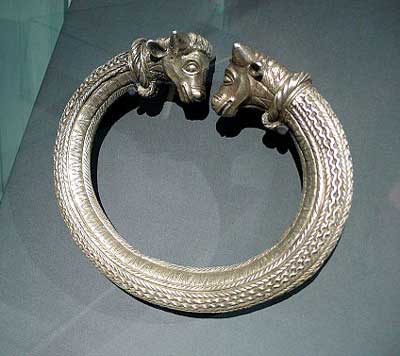 The word "torc" comes from the latin word "torquis", meaning "to twist", since many of the pieces were twisted in shape. There were five main types of torcs:
The word "torc" comes from the latin word "torquis", meaning "to twist", since many of the pieces were twisted in shape. There were five main types of torcs:
- a twisted ribbon, such as a thin strip of gold twisted into a spiral
- a plain circle
- carved with animal heads on the ends
- flared, making a wide crescent shape
- and hollow, with stones or pieces of metal inside them
Celtic Brooch
Celtic brooches were an early version of the safety pin worn by men and women to fasten cloaks or other clothing.
Usually circular, with a long pin going through the middle, every surface was ornately decorated with stylized animals and Celtic knotwork, even the backside, which could not be seen when worn.
The circle is a representation of infinity and may have been influenced by the pagan symbol of the sun.
Both men and women wore brooches. For women, wearing a brooch was a rite of passage into adulthood and they usually did not wear jewelry until they were married.
Men usually wore brooches on their cloak on the shoulder. Women wore them slightly lower and closer to their chest, but also used them as hair pins.
 In time, these brooches became very ornamental and were symbols of wealth and status.
In time, these brooches became very ornamental and were symbols of wealth and status.
Some brooches became so large and the pin so long that they would injure people passing by and laws had to be passed to keep them a reasonable size.
In the 7th and 8th centuries, fine materials like coral from the Mediterranean, enamel, stone and shells further enhanced the beauty of these brooches. They were also a sign of wealth, since only rich people could afford these fine materials.
Some brooches have been found in graves, indicating that they were thought to ensure status and authority even in the afterlife.
In the 8th century, Vikings attacked Ireland, plundering and destroying their monasteries. They brought many fine metals with them and created a new form of brooch - the thistle brooch. They also brought Celtic art back to Scandinavia and helped spread the art of Celtic metalwork.
Summary
I hope this short article leaves you with a slightly better understanding of symbols in Celtic culture. As you have read, many of the symbols are linked to ideas of eternity and infinity, reverence towards nature, or connection to spiritual worlds. Are there Celtic symbols that have a special meaning for you? Let us know about them in the comments!
This article is brought to you by Woot & Hammy - "Our mission is to be a place for Wiccans, Pagans, and others to find affordable, high-quality jewelry that will help them express themselves and their beliefs, and by doing so, help to expand awareness and acceptance of them and their communities." Click here to visit our site.
Image Credits:
Introductory image of Celtic cross - By Tracy from North Brookfield, Massachusetts, USA (Flickr) [CC BY 2.0 (https://creativecommons.org/ licenses/by/2.0)], via Wikimedia Commons
Celtic triquetra drawing - By User:Melian [Public domain], from Wikimedia Commons
Celtic triquetra with circle diagram - By AnonMoos (initial SVG conversion of PostScript source by AnonMoos was done by Indolences) [Public domain], via Wikimedia Commons
Triskele carvings at Newgrange Monument - By Jal74 [CC BY-SA 4.0 (https://creativecommons.org/licenses/by-sa/4.0)], from Wikimedia Commons
Medusa Triskele drawing - By Giuseppe Barberis [Public domain], via Wikimedia Commons
Sailor knots diagram - Public domain, https://en.wikipedia.org/wiki/File:Nf_knots.png#filelinks
Celtic dara knot - https://pixabay.com/en/celtic-knot-silhouette-shape-365844/
Celtic shield knot - Public domain, https://commons.wikimedia.org/wiki/File:Shield_knot_(basic_form,_grey).svg
Celtic cross in graveyard - By Aeris3 [CC BY-SA 4.0 (https://creativecommons.org/licenses/by-sa/4.0)], from Wikimedia Commons
Gold Claddagh ring - I, Royalcladdagh [GFDL (http://www.gnu.org/copyleft/fdl.html), CC-BY-SA-3.0 (http://creativecommons.org/licenses/by-sa/3.0/) or CC BY-SA 2.5 (https://creativecommons.org/licenses/by-sa/2.5)], via Wikimedia Commons
Silver Claddagh ring - By de:Benutzer:Momo, https://commons.wikimedia.org/wiki/File:Ring-of-claddagh.jpg#file
St. Brigid's cross - By Culnacreann [GFDL (http://www.gnu.org/copyleft/fdl.html) or CC BY 3.0 (https://creativecommons.org/licenses/by/3.0)], from Wikimedia Commons
Painting of St. Brigid - By Patrick Joseph Tuohy (HughLane.ie) [Public domain], via Wikimedia Commons
Ogham carvings - By Rosser1954 Roger Griffith [CC BY-SA 3.0 (https://creativecommons.org/licenses/by-sa/3.0) or GFDL (http://www.gnu.org/copyleft/fdl.html)], from Wikimedia Commons and cc-by-sa/2.0 - © kevin higgins - geograph.org.uk/p/1850184
St. Patrick stained glass window - Andreas F. Borchert [CC BY-SA 3.0 de (https://creativecommons.org/licenses/by-sa/3.0/de/deed.en), CC BY-SA 4.0 (https://creativecommons.org/licenses/by-sa/4.0) or GFDL (http://www.gnu.org/copyleft/fdl.html)], from Wikimedia Commons
Cernunnos - Nationalmuseet [CC BY-SA 3.0 (https://creativecommons.org/licenses/by-sa/3.0) or CC BY-SA 2.5 (https://creativecommons.org/licenses/by-sa/2.5)], via Wikimedia Commons
Green Man - https://www.maxpixel.net/Wooden-Old-Green-Man-Decoration-Wood-3369511
Green Man skull - By No machine-readable author provided. SiGarb assumed (based on copyright claims). [Public domain], via Wikimedia Commons
Misty rain on cliffs - https://www.maxpixel.net/The-Water-Cycle-Fog-Water-Water-Droplets-2415242
Beltane fire festival - By Stub Mandrel, https://en.wikipedia.org/wiki/File:Beltane_Fire_Dragon.jpg, https://creativecommons.org/licenses/by-sa/3.0/
Ouroboros circle snake - https://pixabay.com/en/snake-celtic-circle-logo-eating-40427/
Gold Celtic torc - [CC BY-SA 3.0 (https://creativecommons.org/licenses/by-sa/3.0)], via Wikimedia Commons
Silver Celtic torc - By Rosemania (https://www.flickr.com/photos/rosemania/4121249496) [CC BY 2.0 (https://creativecommons.org/licenses/by/2.0)], via Wikimedia Commons
Sideways Celtic brooch - By Johnbod [CC BY-SA 3.0 (https://creativecommons.org/licenses/by-sa/3.0) or GFDL (http://www.gnu.org/copyleft/fdl.html)], from Wikimedia Commons
Gold Celtic brooch - By Johnbod [CC BY-SA 3.0 (https://creativecommons.org/licenses/by-sa/3.0) or GFDL (http://www.gnu.org/copyleft/fdl.html)], from Wikimedia Commons
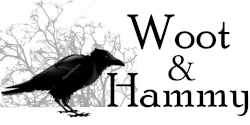




 Celtic Cross
Celtic Cross



196 Comments
NaPpUHGocCbuyzdJ
PHahtMpECBJf
dhMWaGKUx
pNZrvnaqtFzfGhY
ZgSHPzQhekNL